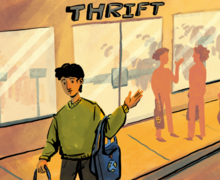SUNY-ESF vice provost for research talks about the history and restoration of Onondaga Lake
Devyn Passaretti | Head Illustrator
After over a century of misuse and pollution, Onondaga Lake is getting revamped, and a group of faculty and students at SUNY-ESF are working on the renewal of the lake, which is central to Syracuse’s history.
Neil Ringler, professor and vice provost for research at the State University of New York College of Environmental Science and Forestry, spoke at the school’s Gateway Center to a full auditorium on Wednesday. His lecture was entitled “Onondaga Lake: Renewal of a Jewel.”
Onondaga Lake was carved around 15,000 years ago and filled with glacial water 10,000 years ago, Ringler said.
The lake was originally a sacred place, where peace was made between the Seneca, Cayuga, Onondaga, Oneida and Mohawk Nations as they formed the Haudenosaunee Confederacy, according to onondaganation.org.
Onondaga Lake remained prosperous throughout the early 1800s, serving as a center of activity and the home to eight major resorts, Ringler said. The lake was so prosperous, in fact, that in the late 1800s, Onondaga Lake Whitefish could be found on menus of New York City restaurants, he added.
The downward spiral of Onondaga Lake began in 1886, he said, when a soda ash factory opened on the lakeshore. Waste was pumped into the lake daily.
From the 1920s to the 1950s, the lake was in the middle of a manufacturing center where waste from salt factories, typewriter production and engine production were deposited. Ringler noted that sewer overflows mixed with storm water also contributed to the pumping of excess nutrients into the lake.
By 1901, the lake was no longer suitable for ice harvesting, and in 1940, it was declared unsafe for swimming. Dissolved oxygen levels plummeted, visibility decreased and blue-green algae levels amplified, Ringler said.
In 1986, 100 years after its inception, the soda ash factory shut down. Shortly thereafter, Ringler said, the salinity level in Onondaga Lake decreased to one-third of what it had previously been.
Then in the 1990s, restoration efforts began. In 1993, SUNY-ESF faculty and students, including Ringler, created artificial spawning sites and wind-protected habitats, which fish responded positively to. They also planted 12 species of aquatic plants.
Following the start of restoration efforts, plant and animal life experienced major growth. Ammonia levels declined and Ringler observed that zebra mussels, which previously could not survive in the lake, thrived.
Pollution levels in the early part of the 20th century, led to a lack in fish diversity — since 1927 there have only been 12 species of fish in the lake. Between 1986 and 2016, restoration efforts proved to be effective, as a total of 64 different species of fish have been recorded in Onondaga Lake, Ringler said.
Fish that have recently arrived in the lake via the canal system include alewife, white bass, white perch, gizzard shad and sheepshead, he added.
Ringler said the water is now healthy enough for natural reproduction to occur, with 20 species of fish now spawning in the lake.
Although oxygen levels remain low in some areas, Ringler and other researchers have found that adding nitrate to the water will help to reverse oxygen depletion while also reducing the concentrations of mercury found in fish. Researchers are currently adding nitrate to the water, evaluating the process on a year-to-year basis.
Factors that contribute to the renewal of the lake include a strong academic environment, an earnest community, students becoming professionals and more than 30 years of work in the Onondaga Lake area, Ringler said.
Restoration efforts are not going to end any time soon. In partnership with Onondaga Community College (OCC), SUNY-ESF received an NY 2020 grant to establish the SUNY Water Research and Education Center at Onondaga Lake, which will contribute to the continuing processes of research and restoration, according to a press release on the OCC website.
Published on April 3, 2016 at 11:03 pm
Contact Taylor: tnwatson@syr.edu





